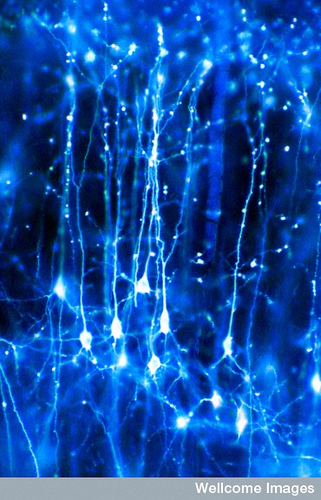Science’s weirdest realm may be responsible for photosynthesis, our sense of smell, and even consciousness itself.

Graham Fleming sits down at an L-shaped lab bench, occupying a footprint about the size of two parking spaces. Alongside him, a couple of off-the-shelf lasers spit out pulses of light just millionths of a billionth of a second long. After snaking through a jagged path of mirrors and lenses, these minuscule flashes disappear into a smoky black box containing proteins from green sulfur bacteria, which ordinarily obtain their energy and nourishment from the sun. Inside the black box, optics manufactured to billionths-of-a-meter precision detect something extraordinary: Within the bacterial proteins, dancing electrons make seemingly impossible leaps and appear to inhabit multiple places at once.
Peering deep into these proteins, Fleming and his colleagues at the University of California at Berkeley and at Washington University in St. Louis have discovered the driving engine of a key step in photosynthesis, the process by which plants and some microorganisms convert water, carbon dioxide, and sunlight into oxygen and carbohydrates. More efficient by far in its ability to convert energy than any operation devised by man, this cascade helps drive almost all life on earth. Remarkably, photosynthesis appears to derive its ferocious efficiency not from the familiar physical laws that govern the visible world but from the seemingly exotic rules of quantum mechanics, the physics of the subatomic world. Somehow, in every green plant or photosynthetic bacterium, the two disparate realms of physics not only meet but mesh harmoniously. Welcome to the strange new world of quantum biology.
On the face of things, quantum mechanics and the biological sciences do not mix. Biology focuses on larger-scale processes, from molecular interactions between proteins and DNA up to the behavior of organisms as a whole; quantum mechanics describes the often-strange nature of electrons, protons, muons, and quarks—the smallest of the small. Many events in biology are considered straightforward, with one reaction begetting another in a linear, predictable way. By contrast, quantum mechanics is fuzzy because when the world is observed at the subatomic scale, it is apparent that particles are also waves: A dancing electron is both a tangible nugget and an oscillation of energy. (Larger objects also exist in particle and wave form, but the effect is not noticeable in the macroscopic world.)
Quantum mechanics holds that any given particle has a chance of being in a whole range of locations and, in a sense, occupies all those places at once. Physicists describe quantum reality in an equation they call the wave function, which reflects all the potential ways a system can evolve. Until a scientist measures the system, a particle exists in its multitude of locations. But at the time of measurement, the particle has to “choose” just a single spot. At that point, quantum physicists say, probability narrows to a single outcome and the wave function “collapses,” sending ripples of certainty through space-time. Imposing certainty on one particle could alter the characteristics of any others it has been connected with, even if those particles are now light-years away. (This process of influence at a distance is what physicists call entanglement.) As in a game of dominoes, alteration of one particle affects the next one, and so on.
The implications of all this are mind-bending. In the macro world, a ball never spontaneously shoots itself over a wall. In the quantum world, though, an electron in one biomolecule might hop to a second biomolecule, even though classical laws of physics hold that the electrons are too tightly bound to leave. The phenomenon of hopping across seemingly forbidden gaps is called quantum tunneling.
From tunneling to entanglement, the special properties of the quantum realm allow events to unfold at speeds and efficiencies that would be unachievable with classical physics alone. Could quantum mechanisms be driving some of the most elegant and inexplicable processes of life? For years experts doubted it: Quantum phenomena typically reveal themselves only in lab settings, in vacuum chambers chilled to near absolute zero. Biological systems are warm and wet. Most researchers thought the thermal noise of life would drown out any quantum weirdness that might rear its head.
Yet new experiments keep finding quantum processes at play in biological systems, says Christopher Altman, a researcher at the Kavli Institute of Nanoscience in the Netherlands. With the advent of powerful new tools like femtosecond (10-15 second) lasers and nanoscale-precision positioning, life’s quantum dance is finally coming into view.
INTO THE LIGHT
One of the most significant quantum observations in the life sciences comes from Fleming and his collaborators. Their study of photosynthesis in green sulfur bacteria, published in 2007 in Nature, tracked the detailed chemical steps that allow plants to harness sunlight and use it to convert simple raw materials into the oxygen we breathe and the carbohydrates we eat. Specifically, the team examined the protein scaffold connecting the bacteria’s external solar collectors, called the chlorosome, to reaction centers deep inside the cells. Unlike electric power lines, which lose as much as 20 percent of energy in transmission, these bacteria transmit energy at a staggering efficiency rate of 95 percent or better.
The secret, Fleming and his colleagues found, is quantum physics.
Related articles





